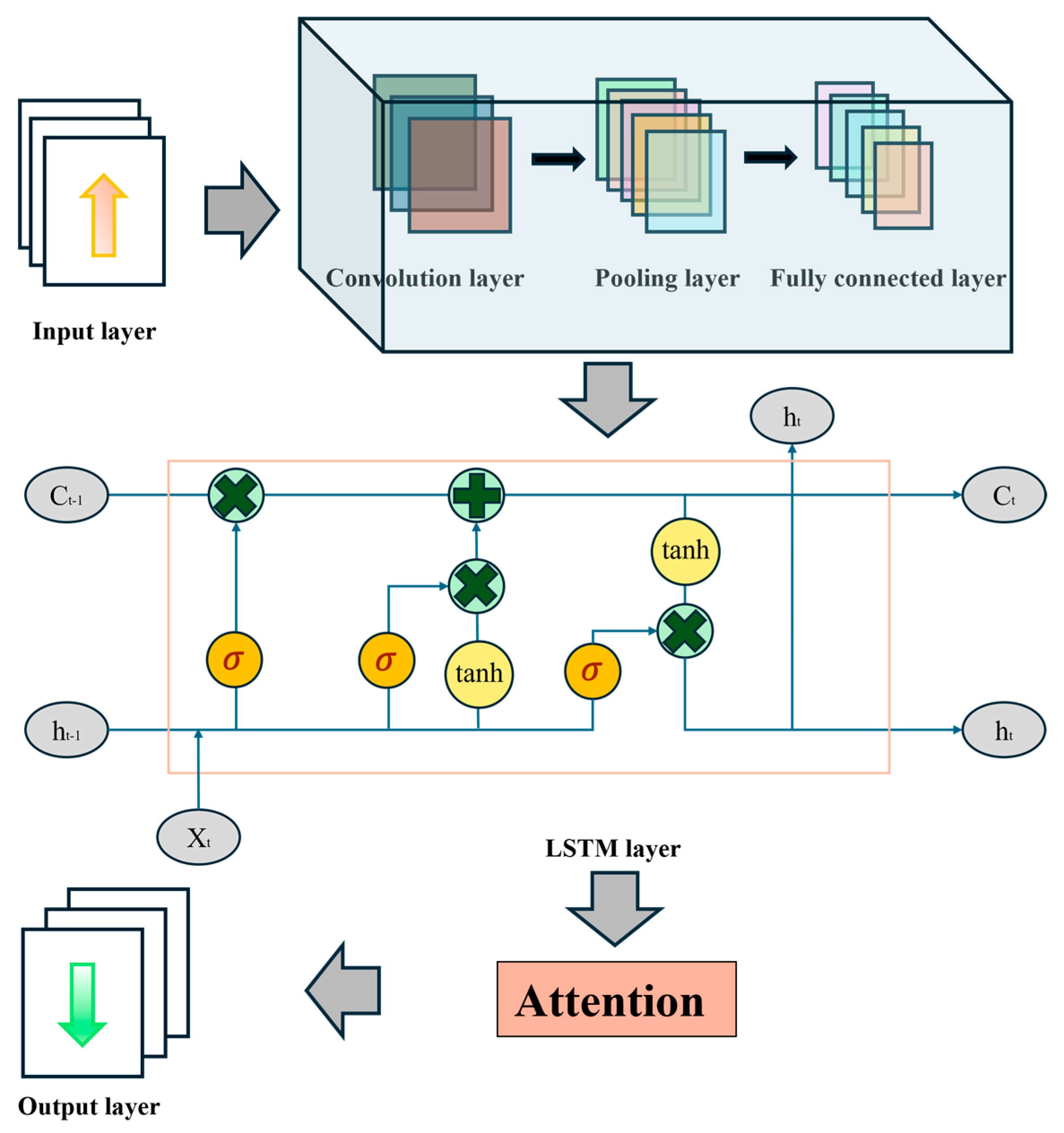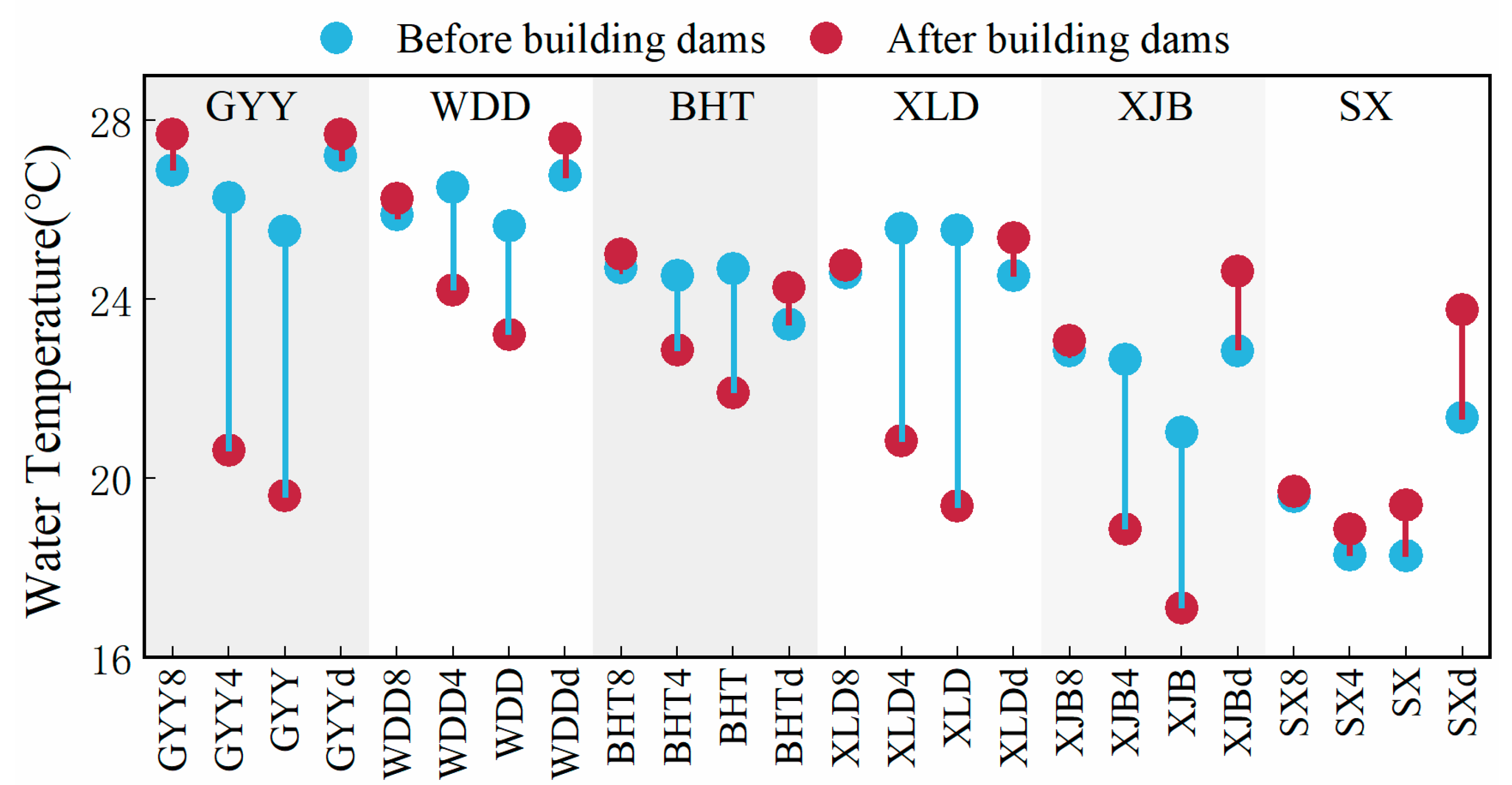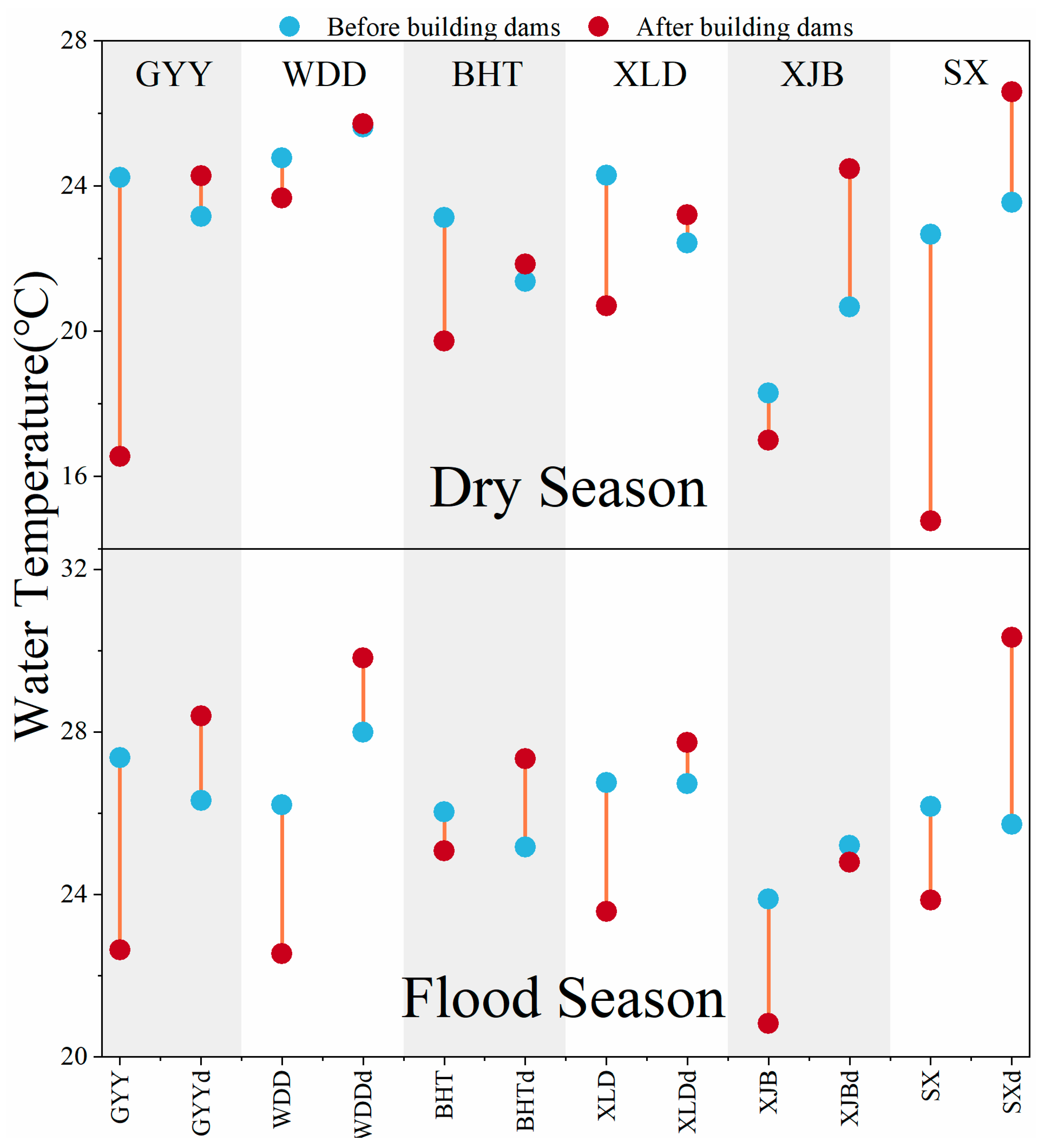Research on the Spatiotemporal Effects of Water Temperature in the Construction of Cascade Dams on the Yangtze River Main Stream Based on Optimized CNN-LSTM Attention Model
Abstract
1. Introduction
2. Materials and Methods
2.1. Study Area
2.1.1. Overview of the Study Area
2.1.2. Section Selection Features
2.2. Research Data Sources
2.3. Research Methodology
2.3.1. Remote Sensing Water Temperature Inversion
2.3.2. Water Temperature Prediction Model
2.3.3. Model Optimization Methods
- It possesses strong global optimization capabilities, enabling it to locate the global optimum.
- The algorithm exhibits high computational efficiency, particularly for high-dimensional optimization problems, effectively reducing computation time.
- It can be applied to a wide range of optimization problems.
2.3.4. Model Evaluation Indicators
3. Results
3.1. Model Validation Results
3.2. Characteristics of Water Temperature Evolution Along the Yangtze River Mainstream
3.3. Characteristics of Water Temperature Changes near the Confluence of Tributaries of the Yangtze River
4. Discussion
4.1. The Impact of Cascade Dam Construction on Water Temperature Evolution
4.2. The Impact of Tributary Confluence on Water Temperature Changes Along the River Channel
4.3. The Impact of Water Temperature Changes on Ecosystems
5. Conclusions
Author Contributions
Funding
Institutional Review Board Statement
Informed Consent Statement
Data Availability Statement
Conflicts of Interest
References
- Wang, J.; Song, Y.; Huang, J. Effects of Increasing Water Temperature on Water Properties and Aquatic Organisms: A Critical Review. J. Hydroecology 2020, 41, 100–109. [Google Scholar]
- Dai, H.; Mao, J.; Jiang, D. Research progress of water-sediment and ecological environment control of large hydropower projects. Water Resour. Hydropower Eng. 2023, 54, 118–125. [Google Scholar]
- Zhang, W.; Shen, X. Remote Sensing Analysis of Spatiotemporal Evolution of Typical Ecological Elements in the Three Gorges Reservoir Area (TGRA). Geomat. Spat. Inf. Technol. 2023, 46, 76–80. [Google Scholar]
- Martí-Cardona, B.; Prats, J.; Niclòs, R. Enhancing the retrieval of stream surface temperature from Landsat data. Remote Sens. Environ. 2019, 224, 182–191. [Google Scholar] [CrossRef]
- Gao, Y.; Lian, X.; Ge, L. Inversion model of surface bare soil temperature and water content based on UAV thermal infrared remote sensing. Infrared Phys. Technol. 2022, 125, 104289. [Google Scholar] [CrossRef]
- Lu, Z.; Li, J. Annual cyclical variations of urban green space cold island(GSCI) effect by combining remote sensing inversion and ENVI-met simulation. Sci. Total Environ. 2024, 951, 175662. [Google Scholar] [CrossRef]
- Pan, Z.; Yang, S.; Ren, X.; Lou, H.; Zhou, B.; Wang, H.; Zhang, Y.; Li, H.; Li, J.; Dai, Y. GEE can prominently reduce uncertainties from input data and parameters of the remote sensing-driven distributed hydrological model. Sci. Total Environ. 2023, 870, 161852. [Google Scholar] [CrossRef]
- Wang, X.; Wu, Y.; Cushman, S.A.; Tie, C.; Lawson, G.; Kollányi, L.; Wang, G.; Ma, J.; Zhang, J.; Bai, T. Spatio-temporal dynamics of water quality and land use in the Lake Dianchi (China) system: A multi-source data-driven approach. J. Hydrol. Reg. Stud. 2025, 59, 102341. [Google Scholar] [CrossRef]
- Chen, D.; Peng, Q.; Lu, J.; Huang, P.; Liu, Y.; Peng, F. Assessing effect of water photovoltaics on nearby water surface temperature using remote sensing techniques. Adv. Space Res. 2025, 75, 138–147. [Google Scholar] [CrossRef]
- Liu, T.; Cui, X.; Mo, L. A Daily Runoff Prediction Model for the Yangtze River Basin Based on an Improved Generative Adversarial Network. Sustainability 2025, 17, 2990. [Google Scholar] [CrossRef]
- Man, Y.; Yang, Q.; Shao, J.; Wang, G.; Bai, L.; Xue, Y. Enhanced LSTM Model for Daily Runoff Prediction in the Upper Huai River Basin, China. Engineering 2023, 24, 229–238. [Google Scholar]
- Cui, Y.; Qiu, K.; Gao, S.; Liu, H.; Gao, R.; Chen, L.; Zhang, Z.; Jiang, J.; Niu, Y.; Wang, C. Multispectral radiation temperature inversion based on Transformer-LSTM-SVM. Opt. Commun. 2025, 590, 132024. [Google Scholar] [CrossRef]
- Belavadi, S.V.; Rajagopal, S.; Ranjani, R.; Mohan, R. Air Quality Forecasting using LSTM RNN and Wireless Sensor Networks. Procedia Comput. Sci. 2020, 170, 241–248. [Google Scholar] [CrossRef]
- Wan, J. Inversion of lake transparency using remote sensing and deep hybrid recurrent models. Ecotoxicol. Environ. Saf. 2025, 297, 118236. [Google Scholar] [CrossRef]
- Zhang, H.; Liu, H.; Shi, Z.; Mao, S.; Chen, N. ConvMamba: Combining Mamba with CNN for Hyperspectral Image Classification. Neurocomputing 2025, 652, 131016. [Google Scholar] [CrossRef]
- Geetha, T.S.; Gandhimathi, G.; Chellaswamy, C.; Thiruvalar Selvan, P. Comprehensive river water quality monitoring using convolutional neural networks and gated recurrent units: A case study along the Vaigai River. J. Environ. Manag. 2024, 365, 121567. [Google Scholar] [CrossRef]
- Xu, H.; Zhang, H.; Wang, Y.; Lu, L.; Wu, A.; Chen, Y.; Li, Y.; Dong, C.; Wang, X. Study on short-term total hardness prediction of water quality based on CNN-BiLSTM-SA model: A case study of Henan Province. J. Water Process Eng. 2025, 75, 107973. [Google Scholar] [CrossRef]
- Chellaiah, C.; Anbalagan, S.; Swaminathan, D.; Chowdhury, S.; Kadhila, T.; Shopati, A.K.; Shangdiar, S.; Sharma, B.; Amesho, K.T.T. Integrating deep learning techniques for effective river water quality monitoring and management. J. Environ. Manag. 2024, 370, 122477. [Google Scholar] [CrossRef]
- Hu, G.; Yang, Z.; Bai, F.; Ren, Y.; Ma, Y.; Li, W. Water temperature’s cumulative effect induced by the construction of cascade reservoirs in the lower reaches of Jinsha River. J. Lake Sci. 2025, 37, 293–303. [Google Scholar]
- Zhang, Y. Twenty years of reservoir impoundment in the Three Gorges: A retrospective and outlook. China Water Resources. 2023, 19, 5–9. [Google Scholar]
- Xu, H. A remote sensing urban ecological index and its application. Acta Ecol. Sin. 2013, 33, 7853–7862. [Google Scholar]
- Zhang, C.; Zhou, Y.; Lu, F.; Liu, J.; Zhang, J.; Yin, Z.; Ji, M.; Li, B. Assessing the performance and interpretability of the CNN-LSTM-Attention model for daily streamflow forecasting in typical basins of the eastern Qinghai-Tibet Plateau. Sci. Rep. 2025, 15, 82. [Google Scholar]
- Shi, L.; Gong, J.; Zhai, C. Application of a hybrid PSO-GA optimization algorithm in determining pyrolysis kinetics of biomass. Fuel 2022, 323, 124344. [Google Scholar] [CrossRef]
- Dong, L.; Niu, Q.; Sun, X.; Cao, W.; Kou, D.; Bai, Z.; Yang, S. Analysis of Impact of Shield Tunneling Parameters on Ground Settlement Based on Pearson Correlation Coefficient Method. Constr. Technol. 2024, 53, 116–123. [Google Scholar]
- He, T.; Deng, Y.; Tuo, Y.; Yang, Y.; Liang, N. Impact of the Dam Construction on the Downstream Thermal Conditions of the Yangtze River. Int. J. Environ. Res. Public Health 2020, 17, 2973. [Google Scholar] [CrossRef] [PubMed]
- Bonacci, O.; Đurin, B.; Bonacci, T.R.; Bonacci, D. The Influence of Reservoirs on Water Temperature in the Downstream Part of an Open Watercourse: A Case Study at Botovo Station on the Drava River. Water 2022, 14, 3534. [Google Scholar] [CrossRef]
- Zaidel, P.A.; Roy, A.H.; Houle, K.M.; Lambert, B.; Letcher, B.H.; Nislow, K.H.; Smith, C. Impacts of small dams on stream temperature. Ecol. Indic. 2021, 120, 106878. [Google Scholar] [CrossRef]
- Yu, Y.; Yang, Z.; Xu, Y.; Cheng, B.; Liu, D.; Ma, J. Influence of Cascade Reservoirs on Water Temperature Change along the Mainstream of Lancang River. J. Yangtze River Sci. Res. Inst. 2019, 36, 18–22. [Google Scholar]
- Zou, S.; Li, Y.; Chen, J.; Zhang, G.; Zhou, X. Temporal and Spatial Variation of Water Temperature in Panzhihua-Yichang Segment of Changjiang River. J. Yangtze River Sci. Res. Inst. 2020, 37, 35–41. [Google Scholar]
- Liu, Z.; Lv, P.; Yu, Y.; Chen, Y. Variation in water temperature of the mainstream of the Jinsha River over last 50 years. Freshw. Fish. 2014, 44, 49–54. [Google Scholar]
- Carron, J.C.; Rajaram, H. Impact of variable reservoir releases on management of downstream water temperatures. Water Resour. Res. 2001, 37, 1733–1743. [Google Scholar] [CrossRef]
- Zhang, H.; Jianan, Z.; Wang, R.; Liu, Y.; Gao, Y.; Wu, F.; Huo, S. Response of lake phytoplankton to climate oscillation on the northeastern Tibetan Plateau: Evidence from a 1400-year-old sedimentary archive. Sci. Bull. 2024, 69, 1208–1211. [Google Scholar] [CrossRef]
- Liao, T. The impact of temperature variation on the algae–zooplankton dynamics with size-selective disturbance. Chaos Solitons Fractals 2024, 181, 114615. [Google Scholar] [CrossRef]
- Lessard, J.L.; Hayes, D.B. Effects of elevated water temperature on fish and macroinvertebrate communities below small dams. River Res. Appl. 2003, 19, 721–732. [Google Scholar] [CrossRef]
- Zhang, H.; Wu, J.M.; Wang, C.Y.; Du, H.; Liu, Z.G.; Shen, L.; Chen, D.; Wei, Q.W. River temperature variations and potential effects on fish in a typical Yangtze River reach: Implications for management. Appl. Ecol. Environ. Res. 2016, 14, 553–567. [Google Scholar] [CrossRef]
- Huang, Z.; Wang, L. Yangtze Dams Increasingly Threaten the Survival of the Chinese Sturgeon. Curr. Biol. 2018, 28, 3640–3647. [Google Scholar] [CrossRef]







| Name | Meaning | Name | Meaning | Name | Meaning |
|---|---|---|---|---|---|
| GYY8 | 80 km in front of Guanyinyan Dam | XLD | 1 km in front of Xiluodu Dam | ZT | Zhutuo Hydrological Station |
| GYY4 | 40 km in front of Guanyinyan Dam | XLDd | 1 km behind Xiluodu Dam | BD | Badong Hydrological Station |
| GYY | 1 km in front of Guanyinyan Dam | XJB8 | 80 km in front of Xiangjiaba Dam | YLJ0 | 1 km upstream of the confluence of Yalong River |
| GYYd | 1 km behind Guanyinyan Dam | XJB4 | 40 km in front of Xiangjiaba Dam | YLJ1 | The confluence of Yalong River |
| WDD8 | 80 km in front of Wudongde Dam | XJB | 1 km in front of Xiangjiaba Dam | YJL2 | 1 km downstream of the confluence of Yalong River |
| WDD4 | 40 km in front of Wudongde Dam | XJBd | 1 km behind Xiangjiaba Dam | MJ0 | 1 km upstream of the confluence of Minjiang River |
| WDD | 1 km in front of Wudongde Dam | SX8 | 80 km in front of the TGD | MJ1 | The confluence of Minjiang River |
| WDDd | 1 km behind Wudongde Dam | SX4 | 40 km in front of the TGD | MJ2 | 1 km downstream of the confluence of Minjiang River |
| BHT8 | 80 km in front of Baihetan Dam | SX | 5 km in front of the TGD | JLJ0 | 1 km upstream of the confluence of Jialing River |
| BHT4 | 40 km in front of Baihetan Dam | SXd | 3 km behind the TGD | JLJ1 | The confluence of Jialing River |
| BHT | 1 km in front of Baihetan Dam | CT | Cuntan Hydrological Station | JLJ2 | 1 km downstream of the confluence of Jialing River |
| BHTd | 1 km behind Baihetan Dam | PZH | Panzhihua Hydrological Station | WJ0 | 1 km upstream of the confluence of the Wujiang River |
| XLD8 | 80 km in front of Xiluodu Dam | HT | Huatan Hydrological Station | WJ1 | The confluence of the Wujiang River |
| XLD4 | 4 km in front of Xiluodu Dam | LJ | Longjie Hydrological Station | WJ2 | 1 km downstream of the confluence of Wujiang River |
| Satellite Source | Band | Wavelength/μm | Data Type | Resolution/m |
|---|---|---|---|---|
| Landsat 5 (TM) | Red: B3 | 0.63~0.69 | C01/T1_SR | 30 |
| NIR: B4 | 0.76~0.90 | C01/T1_SR | 30 | |
| Landsat 7 (ETM+) | Red: B3 | 0.63~0.69 | C01/T1_SR | 30 |
| NIR: B4 | 0.77~0.90 | C01/T1_SR | 30 | |
| Landsat 8 (OLI; TIRS) | Red: B4 | 0.64~0.67 | C01/T1_SR | 30 |
| NIR: B5 | 0.85~0.88 | C01/T1_SR | 30 |
| Hyperparameter | Value | Description |
|---|---|---|
| Number of CNN Filters | 512 | Number of filters used in the CNN layers |
| Kernel Size | 3 | Size of the convolutional kernel(s) in the CNN layers |
| Pooling Size | 2 | Size of the Max Pooling layers |
| BiLSTM Hidden Units | 512 | Number of hidden units in the Bidirectional LSTM layers |
| Multi-head Attention Heads | 6 | Number of heads in the multi-head self-attention mechanism |
| Key Dimension (key_dim) | 128 | Dimensionality of the key vectors in the self-attention mechanism |
| Dense Layer Output Units | 1 | Number of output units in the final fully connected layer |
| Initial Learning Rate | 0.0005 | Initial learning rate for the optimizer |
| Weight Decay | 1 × 10−6 | Weight decay coefficient for the AdamW optimizer |
| Dropout Rate | 0.4, 0.6 | Dropout rates applied in the model (applied to different layers, respectively) |
| Batch Size | 64 | Number of samples per training batch |
| Max Epochs | 500 | Maximum number of training epochs |
| Indicator | RMSE | MAE | NSE | R2 |
|---|---|---|---|---|
| value | 1.38 | 0.9 | 0.90 | 0.92 |
| Yangtze Hydrological Station | Multi-Year Average Discharge (m3/s) | Tributary Confluence Hydrological Station | Multi-Year Average Discharge (m3/s) | Percentage |
|---|---|---|---|---|
| Pingshan Station | 4330 | Gaochang Station | 2475 | 57.16% |
| Zhutuo Station | 7990 | Beibei Station | 1940 | 24.28% |
| Cuntan Station | 10,265 | Wulong Station | 1415 | 13.78% |
Disclaimer/Publisher’s Note: The statements, opinions and data contained in all publications are solely those of the individual author(s) and contributor(s) and not of MDPI and/or the editor(s). MDPI and/or the editor(s) disclaim responsibility for any injury to people or property resulting from any ideas, methods, instructions or products referred to in the content. |
© 2025 by the authors. Licensee MDPI, Basel, Switzerland. This article is an open access article distributed under the terms and conditions of the Creative Commons Attribution (CC BY) license (https://creativecommons.org/licenses/by/4.0/).
Share and Cite
Zhang, S.; Wang, H.; Zhang, R.; Zhang, H.; Zhou, Y. Research on the Spatiotemporal Effects of Water Temperature in the Construction of Cascade Dams on the Yangtze River Main Stream Based on Optimized CNN-LSTM Attention Model. Sustainability 2025, 17, 9046. https://doi.org/10.3390/su17209046
Zhang S, Wang H, Zhang R, Zhang H, Zhou Y. Research on the Spatiotemporal Effects of Water Temperature in the Construction of Cascade Dams on the Yangtze River Main Stream Based on Optimized CNN-LSTM Attention Model. Sustainability. 2025; 17(20):9046. https://doi.org/10.3390/su17209046
Chicago/Turabian StyleZhang, Shanghong, Hao Wang, Ruicheng Zhang, Hua Zhang, and Yang Zhou. 2025. "Research on the Spatiotemporal Effects of Water Temperature in the Construction of Cascade Dams on the Yangtze River Main Stream Based on Optimized CNN-LSTM Attention Model" Sustainability 17, no. 20: 9046. https://doi.org/10.3390/su17209046
APA StyleZhang, S., Wang, H., Zhang, R., Zhang, H., & Zhou, Y. (2025). Research on the Spatiotemporal Effects of Water Temperature in the Construction of Cascade Dams on the Yangtze River Main Stream Based on Optimized CNN-LSTM Attention Model. Sustainability, 17(20), 9046. https://doi.org/10.3390/su17209046






